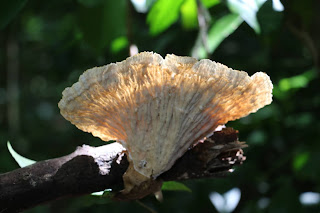One begins a field trip with urban
frenzy and then like a volcano that erupts so does the noise cease after
excited banter that occurs when friends meet, and then in the quiet of the
forest a peace descends as if one is in a meditation. One hears the bird’s
song, the step of one's foot on padded leaves and become acutely aware of the sacredness of the forest.
Escaping the heat of February, we
sought refuge the forest of the Umtumvuna at The Pont, and our Honory officers
took measurements of the area that was required to control with herbicides as
the invasive Bramble invaded 35 m x 5 m deep along the hiking path that leads into the
reserve.
Dorothy with her passion and knowledge took our newest members under her wing and taught us about trees.

|
Our dear Maggie Abbott's walking stick that has a a fork on the end which is
useful when gently pulling a branch down to observe the leaf and flower.
|

|
| A Stink bug that reminded me of an Aborigine in its distinctive markings. |
 |
| Lucia Widow dragonfly female |

|
| Colossal majestic rocks that lie protected on the forest floor. |

|
A mushroom the size of one's hand nestled behing a giant boulder.
Perhaps this is where the fairies meet... |
 |
Slime mould.
It reminded me of a chocolate Flakey. |
 |
| Justicia adhatodoides (Duvernoia adhatodoides) |
|
 |
| Justicia adhatodoides (Duvernoia adhatodoides) |
 |
| Commelina diffusa |
 |
Aneilema aequinoctiale
|
 |
| Buxus natalensis |
 |
| An unusual but unknown fruit/calyx/flower |
 |
| Suregada procera |
 |
| Buxus natalensis |
 |
Celtis gomphophylla

|
 |
| Macaranga capensis - River macaranga |
 |
Drypetes arguta
|
 |
| Laportea peduncularis |
 |
| Cassipourea gummiflua |
 |
The image cannot capture the scale of the enormity of this tree that's having a little lean.
It could easily have seen a century go by. |
 |
Lloyd listening to the birds song and simply enjoying looking up at the canopy of ancient trees.
|
Lloyd ascending the steep slabs of rocks, his singing of a lyric left us all humming happily as we slowly paced ourselves higher up into the forest. One foot in front of other, Dorothy's wish came true.
 |
| A towering wall of Quisqualis parviflora. |
 |
| Quisqualis parviflora |
 |
Nectaropetalum zuluensis
A humorous photo of our tribe as we relaxed at lunch time.
Mark looking a little like he was guillotined...
C.R.E.W. Gail Bowers-Winters, Lloyd, Mark Getliffe, Dorthy McIntyre, Simon, Maggie Abbott
Anne, Tracy Taylor, Anne Skelton and Alf Hayter. |
A special thanks our teachers and and for their dedicated time and sharing their knowledge with those of us who are learning. |




































No comments:
Post a Comment